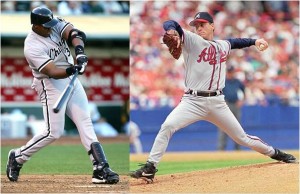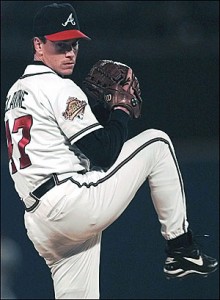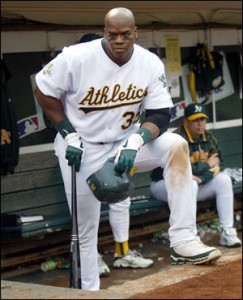Tom Glavine and Frank Thomas: When Will They Be Cooperstown Bound?

Will Frank Thomas and Tom Glavine enter the Hall of Fame when they become eligible in 2014?
Now that Frank Thomas and Tom Glavine have both officially retired from Major League Baseball, it is time for that time honored tradition of debating whether they are Hall of Fame bound.
In both cases, I don’t think it is a matter as much of ‘if” they will get the call from Cooperstown, but instead “when” they will actually receive the prestigious honor.
With first-year nominee Roberto Alomar just missing selection in 2010, it served as a reminder that not everyone who seems a lock to get into the Hall of Fame will receive enough support in their initial year of eligibility.
In fact, when you look at players with comparable careers to both Thomas and Glavine, it might actually be considered a surprise if either of these great players actually reach the 75% mark during their first year of eligibility.
Given that he eclipsed the magical 300-win plateau, it might be a bit of a surprise to suggest that Glavine is not a first ballot lock.
However, both the history of similar candidates and the other candidates on the ballot in 2014 could conspire to hurt Glavine’s chances of first time induction.
Of the 20 pitchers with 300 or more victories and who are now eligible for the Hall of Fame, all 20 have plaques in Cooperstown.
However, of the eight pitchers who have reached 300 victories since 1950, only three (Tom Seaver, Steve Carlton and Nolan Ryan) reached the Hall of Fame in their initial year of eligibility.
Warren Spahn, who has more wins than any other pitcher over the last 60 years, earned induction in his second year while it took Gaylord Perry three attempts, Early Wynn four years and Phil Niekro and Don Sutton each five years.
With 305 career wins, Glavine trails all but Wynn in career victories. His 3.54 career ERA is also higher than all but Wynn, who also had a 3.54 career ERA.
What could work in Glavine’s favor is that throughout his career he was consistently considered to be among the best pitchers in baseball, regularly participated in the post season and rarely suffered a poor campaign.

Glavine won 14 career post season games.
Glavine was a 10-time All-Star, two-time Cy Young Award winner and won 14 post season games during his career. He won 15 or more games in a season 10 times, including five 20+ victory seasons.
One factor that could be interesting in how it impacts Glavine is the two other noteworthy pitchers who will be eligible for the Hall of Fame for the first time in the same year as Glavine.
It would be a major upset if Glavine’s long-time Atlanta Braves teammate Greg Maddux did not earn a spot in the Hall of Fame during his first year on the ballot. In fact, some believe Maddux could become the first player to earn unanimous selection.
His inclusion on the ballot could have one of two different effects on Glavine.
Some may lump the two former Braves together and vote for Glavine in tandem to Maddux. However, others could see a clear distinction between the career numbers of Maddux, with 355 wins and a 3.16 ERA, and those of Glavine and therefore decide that Glavine should wait at least one year.
The other first time candidate in 2014 that could impact Glavine is Mike Mussina. Glavine’s career numbers are significantly better than those of Mussina (270 wins, 3.68 ERA), but he is actually closer to Mussina in wins than he is to Maddux.
If voters take into account the fact that Mussina was clearly the number one pitcher for the Orioles for a decade and was a part of five losing seasons while in Baltimore, it could narrow the gap between Glavine and Mussina.
Voters could rationalize that while Mussina was always facing another number one pitcher, Glavine had the benefit of being part of one of the best staffs of all-time with Maddux and John Smoltz each taking a turn as the ace of the Atlanta staff.
While virtually no one is questioning whether Glavine is worthy of eventually getting into the Hall of Fame, Thomas has heard some questions about his worthiness because of both his position and because of the era in which he played.
Though Thomas has never been linked to steroids and has actually been a vocal anti-steroid advocate, his candidacy could be hampered by the era in which he played.
His career numbers of a .301 batting average with 521 home runs, 1,704 runs and 1,494 runs scored are very impressive. However, considering that 10 of the 25 players all-time with 500+ home runs have come during the last 20 years, Thomas could lose support due to the over inflation of offensive statistics.

Thomas finished his career with the Oakland A's.
Another thing that could also make it tougher for Thomas to receive immediate support is that his numbers over the second half of his career were hardly those of a Hall of Famer.
There is little argument that over the first 10 full seasons of his career Thomas seemed like a synch for Cooperstown.
Thomas finished in the top eight in MVP voting eight times and was the league MVP in back-to-back seasons in 1993 and 1994.
During his first 10 full seasons, he averaged 34 home runs, 115 RBI, 104 runs and a .320 batting average. He eclipsed 100 RBI, .300 batting average and 100 runs nine times during that stretch and hit more than 30 home runs in a season seven times.
However, beginning in 2001, injuries began to take a toll on Thomas and started to steer his Hall of Fame candidacy closer to borderline status.
Thomas missed most of the 2001 season with a shoulder injury. He returned the next two seasons and had solid power numbers with 28 home runs and 92 RBI in 2002 and 42 home runs with 105 RBI in 2003. However, his batting average suddenly took a noticeable dip as he hit .252 in 2002 and .267 the following season.
Injuries again hampered Thomas in 2004 and 2005 and ultimately ended his tenure with the Chicago White Sox.
Playing for the Oakland A’s in 2006, Thomas regained his power numbers with 39 home runs and 114 RBI, but he hit only .270.
After signing with the Toronto Blue Jays in 2007, Thomas hit 26 home runs with 95 RBIs and a .277 average. The next season he split the year between the Blue Jays and A’s while hitting .240 with eight home runs and 30 RBI and was not offered a contract for 2009.
Over the final eight seasons of his career, Thomas hit only .262 to drop his career batting average down to .301. He had only two 100+ RBI seasons and did not score 100 runs in a season during the stretch.
Considering the entire body of work for his career, it would seem that Thomas will one day have a plaque in Cooperstown. However, when you look at other players with similar careers, it might take him a few years to receive that honor.
Much like former Boston Red Sox slugger Jim Rice, Thomas was without question among the best players in the league for a decade, but then quickly dropped to a lower tier. It took Rice 15 years before he finally earned a spot in the Hall of Fame.
Two other sluggers who took a while to earn their place in the Hall of Fame were Tony Perez and Orlando Cepeda. Perez (.279 batting average, 379 home runs, 1,652 RBI) was inducted in his ninth year of eligibility while Orlando Cepeda (.297, 379 home runs, 1,365 RBI) was not selected in 15 years on the ballot and instead was selected by the Veteran’s Committee.
Unlike Glavine, Thomas doesn’t have any other marquee hitters making their Hall of Fame ballot debut in 2014. However, with Barry Bonds and Sammy Sosa beginning their eligibility the previous year and other 500 home run club members Mark McGwire and Rafael Palmeiro potentially still on ballot, it could clutter the field and make it interesting for Thomas.
So, the wait is now officially on for Glavine and Thomas. They can both go ahead and draft their Hall of Fame speeches, but as history has shown, they might want to wait a while before making hotel reservations in Cooperstown.
good post. thanks.
Nice way of explaining this subject, this line of content is very interesting.
He is a lock first. First ballot as well, this is a no brainer peroid.
this is a terrible review. i cannot believe you're comparing FRANK THOMAS to perez and cepeda.
I love that blog layout ! How was it made. Its very sweet!
Incredible points. Outstanding arguments. Keep up the great spirit.
my web-site; 正規 スクエアトゥ 激安
Un imposant bravo à l’administrateur du site internet
I couldn’t refrain from commenting. Perfectlyy written!
My web-site doterra on guard flu
POzhax Utterly indited content, appreciate it for selective information. Life is God as novel. Let him write it. by Isaac Bashevis Singer.